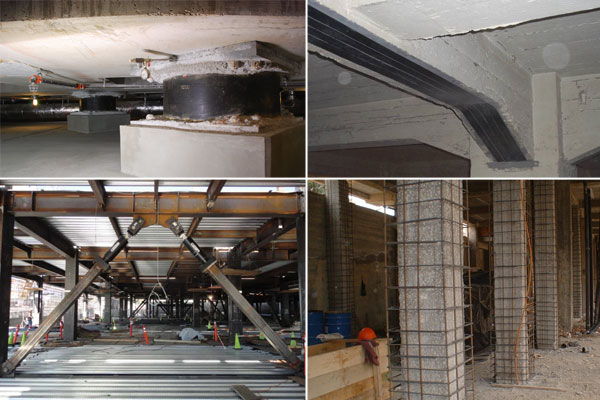Introduction:
Earthquakes are natural disasters that pose significant risks to buildings and infrastructure, particularly in seismically active regions. Retrofitting, the process of strengthening existing structures to improve their resistance to seismic forces, is a crucial strategy for reducing vulnerability and enhancing resilience in earthquake-prone areas. In this blog post, we will delve into the importance of retrofitting, explore common retrofitting techniques, and highlight the role of civil engineers in seismic vulnerability reduction.
Understanding Seismic Vulnerability:
Seismic vulnerability refers to the susceptibility of buildings and infrastructure to damage or collapse during an earthquake. Factors that contribute to seismic vulnerability include poor construction quality, inadequate structural design, aging infrastructure, and lack of seismic-resistant features. Retrofitting aims to address these vulnerabilities by reinforcing existing structures to withstand the forces exerted by earthquakes and minimize the risk of damage or collapse.
Importance of Retrofitting:
Retrofitting existing buildings and infrastructure is essential for protecting lives, property, and critical infrastructure in earthquake-prone areas. Unlike new construction, retrofitting presents unique challenges due to existing site conditions, structural configurations, and occupancy requirements. However, retrofitting offers numerous benefits, including:
1. Enhancing Public Safety:
Retrofitting improves the seismic performance of buildings and infrastructure, reducing the likelihood of collapse and minimizing the risk of injury or loss of life during earthquakes. Strengthening critical facilities, such as hospitals, schools, and emergency response centers, is particularly important for ensuring continuity of essential services following a seismic event.
2. Preserving Cultural Heritage:
Many historic and culturally significant structures are vulnerable to earthquakes due to their age and construction methods. Retrofitting enables the preservation of these landmarks, ensuring that they remain safe and accessible for future generations to enjoy. Retrofitting historic buildings also helps maintain community identity and heritage.
3. Reducing Economic Losses:
Earthquakes can cause significant economic losses through property damage, business interruption, and infrastructure repair costs. Retrofitting reduces the financial impact of earthquakes by minimizing damage to buildings and infrastructure, protecting valuable assets, and ensuring business continuity.
Common Retrofitting Techniques:
Civil engineers employ a variety of retrofitting techniques to strengthen existing structures and improve their seismic performance. Some common retrofitting techniques include:
1. Implementing Base Isolation:
Base isolation is a sophisticated retrofitting technique that involves isolating a building’s superstructure from its foundation using bearings or isolators. These isolators absorb and dissipate seismic energy, reducing the transfer of forces to the structure above. Base isolation can significantly improve a building’s seismic performance by isolating it from ground motion and minimizing damage to structural elements.
2. Strengthening Masonry Structures:
Masonry structures, such as unreinforced brick or stone buildings, are particularly vulnerable to earthquakes due to their brittle nature. Retrofitting techniques for strengthening masonry structures may include adding reinforced concrete or steel frames, installing retrofit anchors or ties, and applying external reinforcement, such as fibre-reinforced polymers (FRP) or shotcrete. These measures enhance the ductility and capacity of masonry structures to withstand seismic forces.
3. Conducting Seismic Hazard Assessments:
Before implementing retrofitting measures, civil engineers conduct comprehensive seismic hazard assessments to evaluate the seismic risk posed to existing structures. Seismic hazard assessments involve analysing historical seismic data, geological studies, ground motion predictions, and site-specific factors to assess the potential impact of earthquakes on buildings and infrastructure. This information guides the selection of appropriate retrofitting techniques and prioritizes retrofitting efforts based on risk levels.
4. Monitoring and Maintenance:
Once retrofitting measures are implemented, ongoing monitoring and maintenance are essential to ensure the continued effectiveness and performance of retrofit solutions. Civil engineers conduct regular inspections, structural assessments, and performance evaluations to identify any signs of deterioration, damage, or changes in seismic risk. Maintenance activities may include repairing damaged components, replacing worn-out materials, and updating retrofit designs to meet evolving standards and requirements.
Conclusion:
Retrofitting for seismic vulnerability reduction is a multidisciplinary endeavor that requires collaboration among civil engineers, structural designers, architects, and building owners. By implementing retrofitting measures, existing structures can be strengthened to withstand seismic forces and mitigate the risk of damage or collapse during earthquakes. Civil engineers play a central role in the retrofitting process, leveraging their expertise to assess seismic risk, design retrofit solutions, and ensure the safety and resilience of buildings and infrastructure. As seismic hazards continue to pose challenges worldwide, retrofitting remains a critical strategy for reducing vulnerability and building more resilient communities





